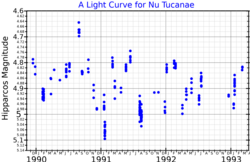Astronomy:Nu Tucanae
| Observation data Equinox J2000.0]] (ICRS) | |
|---|---|
| Constellation | Tucana |
| Right ascension | 22h 33m 00.06240s[2] |
| Declination | −61° 58′ 55.6390″[2] |
| Apparent magnitude (V) | 4.75 - 4.93[3] |
| Characteristics | |
| Spectral type | M4 III[4] |
| U−B color index | +1.73[5] |
| B−V color index | +1.61[5] |
| Variable type | Lb:[6] |
| Astrometry | |
| Radial velocity (Rv) | −3.4±0.8[7] km/s |
| Proper motion (μ) | RA: −3.40[2] mas/yr Dec.: −0.8[2] mas/yr |
| Parallax (π) | 11.24 ± 0.23[2] mas |
| Distance | 290 ± 6 ly (89 ± 2 pc) |
| Absolute magnitude (MV) | +0.16[8] |
| Details | |
| Radius | 49.39+5.65 −7.73[9] R☉ |
| Luminosity | 400±11[9] L☉ |
| Temperature | 3,674+326 −194[9] K |
| Other designations | |
| Database references | |
| SIMBAD | data |
ν Tucanae, Latinized as Nu Tucanae, is a solitary,[11] variable star in the southern constellation of Tucana. This red-hued object is visible to the naked eye as a faint star with an apparent visual magnitude that fluctuates around +4.80.[5] It is located approximately 290 light years from the Sun based on parallax,[2] but is drifting closer with a radial velocity of −3 km/s.[7]
This object is an aging red giant with a stellar classification of M4 III,[4] currently on the asymptotic giant branch.[6] With the supply of hydrogen exhausted at its core, the star has cooled and expanded off the main sequence; at present it has 49 times the Sun's radius.[9] It is classified as a slow irregular variable and its brightness varies from magnitude +4.75 to +4.93.[3] Cyclical periods of 22.3, 24.4, 24.8, 25.1, 25.5, 33.8, 50.6, 80.1, 123.2, and 261.8 days have been reported for its variations.[12] On average, the star is radiating around 400[9] times the luminosity of the Sun from its photosphere at an effective temperature of 3,674 K.[9]
References
- ↑ Hipparcos Tools Interactive Data Access, ESA, https://www.cosmos.esa.int/web/hipparcos/interactive-data-access, retrieved 8 December 2021.
- ↑ 2.0 2.1 2.2 2.3 2.4 2.5 van Leeuwen, F. (2007), "Validation of the new Hipparcos reduction", Astronomy and Astrophysics 474 (2): 653–664, doi:10.1051/0004-6361:20078357, Bibcode: 2007A&A...474..653V.
- ↑ 3.0 3.1 Samus, N. N. et al. (2009), "General Catalogue of Variable Stars (Samus+ 2007-2013)", VizieR On-line Data Catalog: B/GCVS. Originally Published in: 2009yCat....102025S 1, Bibcode: 2009yCat....102025S.
- ↑ 4.0 4.1 Houk, Nancy (1979), Michigan catalogue of two-dimensional spectral types for the HD stars, 1, Ann Arbor, Michigan: Dept. of Astronomy, University of Michigan, Bibcode: 1978mcts.book.....H.
- ↑ 5.0 5.1 5.2 Cousins, A. W. J. (1964), "Photometric Data for Stars in the Equatorial Zone (Seventh List)", Monthly Notes of the Astronomical Society of Southern Africa 23: 175, Bibcode: 1964MNSSA..23..175C.
- ↑ 6.0 6.1 Sloan, G. C.; Price, S. D. (December 1998), "The Infrared Spectral Classification of Oxygen-rich Dust Shells", The Astrophysical Journal Supplement Series 119 (2): 141–158, doi:10.1086/313156, Bibcode: 1998ApJS..119..141S.
- ↑ 7.0 7.1 Gontcharov, G. A. (November 2006), "Pulkovo Compilation of Radial Velocities for 35495 Hipparcos stars in a common system", Astronomy Letters 32 (11): 759–771, doi:10.1134/S1063773706110065, Bibcode: 2006AstL...32..759G.
- ↑ Anderson, E.; Francis, Ch. (2012), "XHIP: An extended hipparcos compilation", Astronomy Letters 38 (5): 331, doi:10.1134/S1063773712050015, Bibcode: 2012AstL...38..331A.
- ↑ 9.0 9.1 9.2 9.3 9.4 9.5 Brown, A. G. A. (August 2018). "Gaia Data Release 2: Summary of the contents and survey properties". Astronomy & Astrophysics 616: A1. doi:10.1051/0004-6361/201833051. Bibcode: 2018A&A...616A...1G. Gaia DR2 record for this source at VizieR.
- ↑ "nu Tuc". SIMBAD. Centre de données astronomiques de Strasbourg. http://simbad.u-strasbg.fr/simbad/sim-basic?Ident=nu+Tuc.
- ↑ Eggleton, P. P.; Tokovinin, A. A. (September 2008), "A catalogue of multiplicity among bright stellar systems", Monthly Notices of the Royal Astronomical Society 389 (2): 869–879, doi:10.1111/j.1365-2966.2008.13596.x, Bibcode: 2008MNRAS.389..869E.
- ↑ "Long-term photometry and periods for 261 nearby pulsating M giants", Monthly Notices of the Royal Astronomical Society 400 (4): 1945, 2009, doi:10.1111/j.1365-2966.2009.15588.x, Bibcode: 2009MNRAS.400.1945T.
 |


